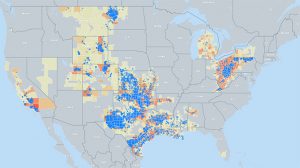 A few months ago, the Environmental Protection Agency released their proposal to eliminate regulation of methane emissions from new and modified sources across the oil and gas sector and attempt to preclude future federal regulation of the vast number of older sources in the industry.
A few months ago, the Environmental Protection Agency released their proposal to eliminate regulation of methane emissions from new and modified sources across the oil and gas sector and attempt to preclude future federal regulation of the vast number of older sources in the industry.
EDF and a coalition of other concerned public health and environmental organizations submitted detailed comments to the EPA during the public comment period that ended last month, underscoring that the Trump EPA proposal is deeply flawed and unlawful. The proposal is essentially an attempt to dodge the agency’s responsibilities under the Clean Air Act and ignores the extensive scientific evidence that pollution from the oil and gas sector is a public health threat.
There are more than 850,000 older wells in the United States that are currently unregulated by EPA and that would forever be exempted from federal regulation by this move. In 2025, these wells and other unregulated facilities will emit over three million tons of methane, two million tons of smog-forming volatile organic compounds, and over a hundred thousand tons of air toxics like cancer-causing benzene — pollution that would be prevented by the modest federal standards that the Trump EPA’s plan would seek to preclude.
New mapping tool shows who will be impacted by EPA’s dangerous methane rollback Share on XThose numbers are big and will mean more harmful pollution in communities all across the country. But because there are so many well sites across the country, it’s nearly impossible to visualize how many people would be impacted by the blatant abdication of EPA’s core responsibilities.
So we made a map that shows you, in detail, where these wells are, how close they are to where people live and how much additional pollution will be allowed by the Trump EPA rollbacks. Chances are, you or someone you know lives in a pollution zone where wells will never be subjected to federal standards, if the Trump EPA were to finalize its proposal.
The map includes onshore oil and gas wells in the United States that were reported active in 2018 and 2019. We then split those wells into two categories: those subject to EPA “new source” regulations, and older wells. These older wells, if the Trump EPA rollback proposal goes through, would never be subject to federal regulations.
Then, we merged the well dataset with U.S. Census population data so we could see how close these facilities are to people. And if millions more tons of methane pollution didn’t surprise you, knowing how many people live within half a mile of an oil or gas well — and are exposed to the corresponding smog and toxic air pollution — might.
Nine and a half million. And the overwhelming majority (9.3 million) of those people live within half a mile of one of the older wells that the Trump administration’s proposal would seek to leave forever unregulated by the EPA.
The overwhelming majority of these people are groups who are much more susceptible to the health impacts of polluted air (children and adults over 65) or have historically borne an oversized burden of local air pollution (people of color and people living below the poverty line).
The EPA has a simple and uncontested mission: to protect human health and protect the environment. If you click through the map for only five minutes, it will become clear that these oil and gas rollbacks fail Americans on both counts.









